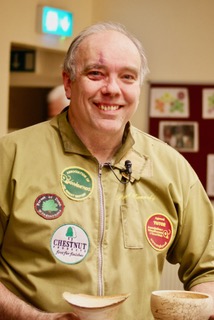There was a good turnout for today’s meeting, with the demonstration by Paul Hannaby. As soon as everything had been set up, Paul began his demonstration, making two bowls. After the first bowl and a quick break for tea he resumed the demo, continuing until it was time to clear everything away.
Demo by Paul Hannaby (www.hannaby.com/) (www.creative-woodturning.com/)
Spalted Beech Bowl – After a short introduction, Paul mounted a spalted beech blank onto a screw chuck and trued up the face before forming a tenon using a spindle gouge with fingernail grind.
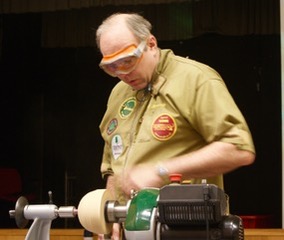
He shaped the outside with a bowl gouge, refining the shape where necessary with a fine shear cut using the wing of the fingernail grind. A slicing bevel-supported cut gives a better surface finish but he finds that is not quite so controllable in shaping the curve. He also demonstrated the use of a scraper in place of the wing of the gouge.
Paul explained that a parabola makes a nice bowl shape, and this can be illustrated by holding a piece of chain at both ends, allowing the chain to fall into a parabola shape. By varying the distance between the ends of the chain, the height and curve of the parabola can be changed until a pleasing shape presents itself as the best option.
Once happy with the shape, it was chuck mounted on the tenon and the tailstock removed to allow room for sweeping the bowl gouge smoothly throughout the full arc whilst hollowing. This allows the gouge to remain supported by the bevel all the way to the centre of the bowl, making sure no pimple is left at the centre.
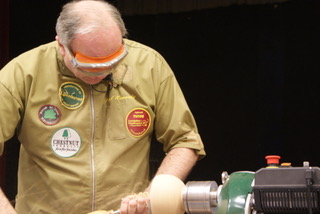
He started hollowing a few cm from the middle, working towards the centre. Taking care to start the cut positively in order to avoid the tool skipping, the tool handle was held well away and down, so that there was bevel support as it entered the cut, raising the handle as he pulled it towards him to finish at the centre.
Paul explained that it is important to stand in a suitable position to swing the gouge smoothly all the way through the curve – and to be aware that the range of movement increases as the hollowing progresses.
Once the basic shape was achieved it was refined: mainly by taking more out of the centre to deepen the bowl and maintain a regular wall thickness.
As the bowl became deeper, the 3/8” bowl gouge began chattering on the bottom – a sign that the bevel angle of just under 50 degrees was not suitable for the width/depth ratio of the bowl. He switched to a similar gouge, but with a bevel angle of just under 60 degrees allowing better bevel support. There was less chatter but the start position entailed reaching over the lathe still further.
At this point, Paul would normally have sanded inside the bowl but, as tea break was called, didn’t do so. Also to save time on this occasion he didn’t, as he would normally do, reverse the chuck onto a padded mandrel approximately matching the internal curve of the bowl, hold it in place with the tailstock, finish the foot, and sand the outside.
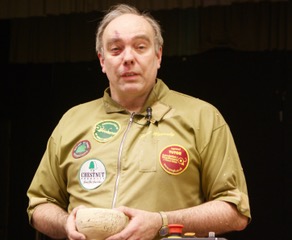
For a simple bowl like this, he would treat it with a foodsafe mineral oil, to be re-applied periodically by the bowl’s owner.
Natural Edged Maple Bowl – The blank for this bowl (thought to be maple) showed a number of small cracks, hopefully to be removed in the process. As usual with NE bowls, care is advisable in mounting the blank so that the bowl will be of regular thickness and even “wing” heights.
This was achieved by mounting it between centres (bark end towards headstock), and adjusting it off-centre on the tailstock end to orient the NE as desired in all planes. The blank was out of balance, necessitating low initial revs, but the main concern is to achieve even wings on the finished product.
Before starting turning, the 4-point spur drive was manually milled through the bark into solid wood, to give better contact. Paul did this by turning the wood by hand whilst applying pressure by winding the tailstock in but it could have been done by drilling with a Forstner bit.
Face protection is always advisable when woodturning, but doubly so when there is bark involved, as it is likely to fly off, and it may contain stones or other foreign bodies.
Paul trued up the end face, using light cuts initially to remove the high points, and then used dividers to mark a chucking tenon. The tenon was cut out using a bowl gouge, taking care to ensure that it was less high than the chuck jaw depth.
Initial shaping of the outside was at a slow speed, and cutting outwards towards the rim – but stopping short of the bark edge to reduce the risk of it coming off. Paul explained that winter-cut wood is also better in this respect; the bark is less likely to come off than with actively growing wood.
The outside edge was shaped by cutting inwards from the rim (against the grain), taking care to find the invisible, spinning edge before moving the tool forward.
Shaping continued with alternating the directions of cut as above until the shape was satisfactory.
The bowl was mounted on the chuck, taking care to centre it accurately as the final wall thickness will only be 2 to 3mm. If unable to to do this, Paul would first take a cut on the outside to true it up before hollowing.
As hollowing with the bowl gouge progressed, Paul noticed that the ings were thinner than the rest of the body so he corrected this on the next cut, removing wood only where required. Once below 5mm thickness, he continued in stages from the free end, not returning to the thin sections once completed as they were no longer stable. The thickness was gauged by shining a light through the bowl wall.
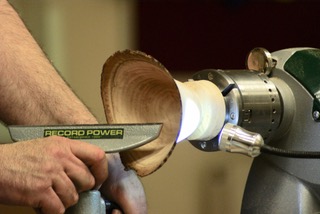
Unlike the beech bowl made earlier, the shape of this bowl was suitable to complete using the bowl gouge with 50 degree bevel.
Having gone as far as time allowed this evening, Paul will later sand the bowl by hand, mounting it on a padded mandrel for doing the outside. He will finish it with oil and does not expect it to crack any further although an original crack was still visible. Being thin, such bowls will warp rather than crack if wet.
Paul gave a lot of tips and explanations while he was working, all of which made for a thoroughly engrossing demonstration, and the evening passed all too quickly before it was time to pack everything away. And… despite having crammed in so much into a short period, Paul also managed to find time to have a chat with some of us about AWGB membership in his capacity as AWGB Chairman – many thanks for your time Paul, much appreciated!
